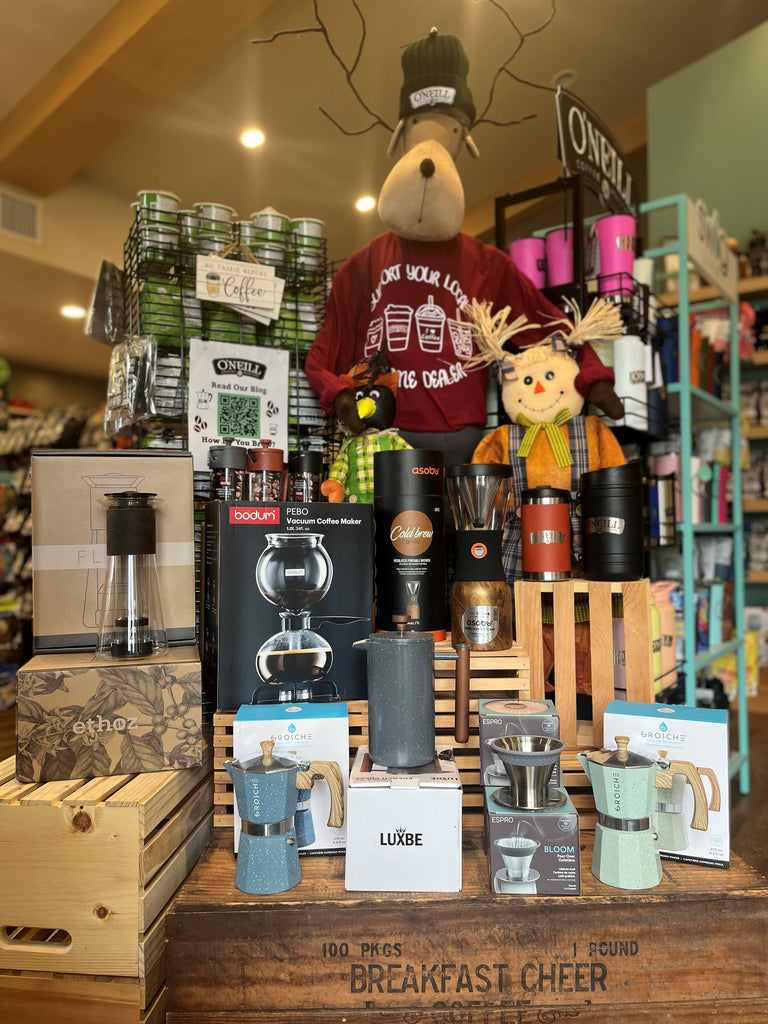How Do You Brew? - A Journey Through Different Brewing Methods

How do you brew? – A Journey Through Different Brewing Methods
Introduction:
Coffee, through the years, has evolved into an art form with different methods and techniques. These methods transcend the ordinary (drip, percolator, etc..) creating brews that capture the essence of the beans in ways that traditional drip brewing cannot. In this blog post, we dive into the world of specialty coffee brewing methods, exploring the differences, the science, and the artistry that define each approach.
Pour-Over Brewing:
Pour-over brewing stands as a testament, that simplicity can lead to perfection. This method is defined by the interaction between water, coffee grounds, and gravity. Cone-shaped drippers are a popular pour-over with their spiral edges, allowing for a controlled extraction process. Pour-over is not just a method; it is an intimate ritual where coffee becomes an orchestra of flavors through a simple process.
Pour-over brewing is a slow, deliberate process with the water pouring in gentle circles over the grounds. The bloom, that initial moment when the coffee releases trapped gases, sets the stage for what’s to come. Throughout the brew, it is best to keep a consistent flow of water, however, many recipes differ in water flow. The pour-over should be finished in around 3 minutes with a 30-second bloom. The result is a cup that carries the brewer’s touch and a unique drinking experience.
French Press Brewing:
The French Press method is more straightforward; however, it does not lack flavor. Here, coffee and water engage in a timed immersion, leading to a brew that is unique in its mouthfeel and flavor. It is a great method for those who are looking for a full-bodied coffee experience that brings a load of flavor.
French Press brewing is a simple process that starts with a bloom and finishes with the plunge of a metal mesh filter. Most recipes recommend a 4-minute total extraction with a 30-second bloom. The mesh filter allows for some of the fine coffee particles to pass through, adding to the coffee’s complex texture. With every sip, the drinker experiences an exploration of the coffee’s body and flavors brought by an immersion process.
AeroPress Brewing:
AeroPress is a relatively new device that has been gaining a lot of traction within the coffee industry. It has built itself a reputation for producing some of the best coffee brews. It’s a method that brings experimentation in changing grind size, water temperature, and steeping time. These adjustments can get different results in every brew. AeroPress brewing is a pathway for coffee brewers to create unique coffee experiences.
The AeroPress is an immersion method that relies on pressure for extraction. With its versatility, there are countless recipe options, including many from the AeroPress World Championships. The simple act of pressing the plunger brings a concentrated array of flavors. AeroPress is a testament that an expensive espresso machine is not needed to create a good cup of coffee.
Moka Pot Brewing:
The Moka pot, often referred to as a stovetop espresso maker, stands as a bridge between the worlds of espresso and regular coffee. This method holds a special place in the hearts of those who appreciate a strong, concentrated brew with a touch of nostalgia. It's a testament that innovation doesn't always require high-tech gadgets. The design is inspired by traditional old-world brewing.
The brewing process is complex and requires precision in every brew. Grind size, water level, and heat all play important roles in the Moka Pot’s performance. As steam pressure builds, water from the bottom chamber forces its way through the coffee and into the upper chamber. The steam creates a wonderful aroma as the brew reaches its finale. The rich, intense coffee can be used for a variety of coffee-based drinks, like lattes and cappuccinos, showcasing the Moka Pot’s versatility.
Siphon (Vacuum Pot) Brewing:
Siphon brewing is a unique method that involves pressure differentials and vacuum forces. The siphon apparatus looks like a scientific experiment; however, the outcome is a delicate cup of coffee that captures the subtle notes of the beans. The method creates a remarkably clean brew due to the process of trapping fine particles in the vacuum process. It is a display of ingenuity and aesthetics, resulting in an exceptionally smooth and visually captivating brew.
This method of siphoning coffee can seem very complicated but with the right temperature and timing, the brew is phenomenal. Water rests in the bottom carafe until it reaches boiling point, from there, the water rises to meet the coffee in the top chamber. After getting the desired immersion time, the brewed coffee falls into the carafe with the vacuum, creating an aesthetic brewing experience.
Conclusion:
Specialty coffee brewing methods aren't just ways to prepare a cup of coffee; they're avenues for exploration, self-expression, and connection. Each method embodies a unique philosophy, from the meticulous craftsmanship of pour-over to the experimental nature of AeroPress. Through these methods, coffee transforms from a beverage into an experience, a journey that connects the brewer with the beans and the artistry within every sip. Whether you seek the elegance of a pour-over or the immersive intensity of a French Press, the world of specialty coffee brewing methods offers a canvas for discovering coffee in its most vibrant and diverse forms.
Written by – Lucio Chrestay
